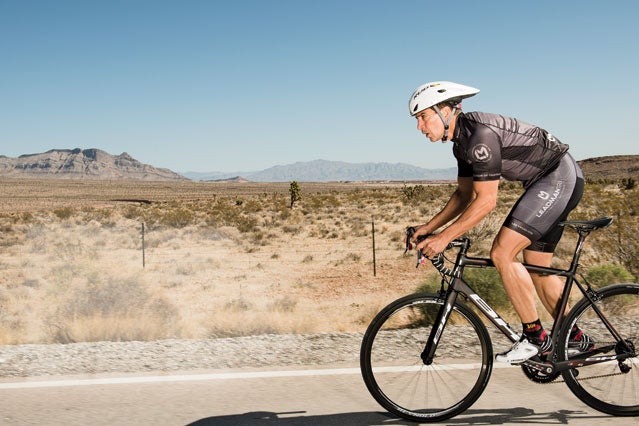Past the Costco, the Mattress Giant, and the manicured suburban townhomes of Eden Prairie, Minnesota, more than 50 cyclists are hurrying through a sleet storm to enter . One of 105 of the megabox health-club chain’s outlets, which run from Texas to Ontario, the facility covers 232,000 square feet and houses tennis and basketball courts, yoga studios, and roughly 400 cardio and fitness machines, plus a bar, a restaurant, and luxurious changing rooms. This evening, the spinners—from elite mountain bikers training for the Leadville 100 to hyperfit soccer moms—will have their asses handed to them by Life Time founder, CEO, president, chairman, and frequent instructor Bahram Akradi.
“I’m your daddy tonight! There is no slacking off!” he yells, pedaling to an up-tempo remix of “Black Magic Woman.” “Find that beat! Let’s go! Quit talking! Focus! Push it!”
Akradi, 51, started the company in 1992, and it has since grown into a $1 billion fitness empire. Over the past decade, Akradi has also slowly positioned Life Time to be the largest athletic-event brand in the country, creating or acquiring more than 200 annual races in 23 states.
Most recently, Akradi has focused on ultra-distance endurance competitions. In 2010, Life Time purchased Colorado’s iconic , which includes the highest and arguably toughest 100-mile mountain-bike race in the country, the Leadville 100. In 2011, it purchased the in Hayward, Wisconsin—among the oldest and most respected grassroots mountain-biking events in the U.S. And last year, Akradi launched the Leadman 250 triathlon, his own version of Ironman, with a 5K swim, 223K bike, and 22K run. The second Leadman 250 will be held on September 22, in Bend, Oregon.
The intrusion of a fitness-club magnate into the niche world of ultra races has many endurance athletes mystified. What, they wonder, is Akradi up to? And, more pressingly, what will happen to the ultra world’s offbeat and beloved small events once they’re run by corporate America?
Life Time is such a success story that last fall Jim Cramer, of CNBC’s Mad Money, called it “the Whole Foods of the fitness business.” In 2011, the publicly traded company, headquartered in Chanhassen, Minnesota, earned more than a billion dollars in revenue. This year, that number is on track to increase by at least $100 million. And while races still account for only one percent of the dollars coming in, Life Time intends to be a dominant player in that world, too. Akradi anticipates annual revenue from Life Time events increasing from $10 million to $100 million over the next six to seven years, with more acquisitions on the horizon. He won’t reveal what those are but says that Life Time is looking to buy events that “are really coveted.”
“Our goal is to be the best athletic-event company in America,” Al Iverson, president of Life Time Fitness Athletic Events, adds. “Eventually, that might mean the biggest.”
There’s good reason to think Akradi will make it happen. He emigrated from his native Iran in 1978 to study electrical engineering at the University of Colorado, covering his tuition by cleaning pools and selling memberships at Nautilus Swim and Fitness. Upon graduating, he was sent to open a Nautilus club in suburban Minneapolis. He left the company, which had been acquired by Bally Total Fitness, in 1989 and started Life Time in 1992. At the end of 2001, the company had 22 clubs, with revenue of $136 million.
In 2002, Akradi entered the triathlon world with a bang, putting up a $50,000 prize for the winner of his inaugural Olympic-distance Life Time Fitness Triathlon, in Minneapolis. (The first-place prize at the ITU Triathlon World Championships that year was $20,625.) The next year, he increased the winnings to $250,000.
“It was like a wreck on the freeway—you had to look,” says John Duke, vice president of global sales and marketing for Ironman, of the extravagant purse. “It was the richest event in the sport. I give him credit for putting up that kind of money. He changed a lot of triathletes’ lives. He’s almost like Howard Hughes or the Wizard of Oz.”
The dollar signs made Life Time an instant force in the triathlon world, and established races were forced to follow its lead. Today the prize purse for the XTerra World Championship is $105,000. The sum for the eight-event 2012 ITU World Triathlon series (including the year-end bonus pool) is $2 million. For its part, Life Time awards more than half a million dollars in a broad spectrum of events, including a $50,000 purse divided among the winners of the Leadman 250 in Bend.
Akradi expanded into tris just as participation was exploding—in 2010, an estimated 2.3 million Americans competed in at least one on- or off-road triathlon—but his choice to jump into the hardcore ultraracing market is a bigger gamble. Participation in ultra events is increasing, but according to Active Network, a technology company that powers thousands of races, the boom is relatively small: over the past decade, some 317 domestic events attracted roughly 32,000 racers.
“Races like Leadville probably make as much money as the rest of his company makes in a day,” says Ed McCall, a private-equity investor and former chairman of Spectrum Clubs, a Life Time competitor. McCall, who has known Akradi for years and describes him as “a hard-driving entrepreneur,” believes that Life Time’s foray into events is largely a branding initiative. “If you look at it that way, it might be really inexpensive marketing dollars,” he says. “His business is gigantic cookie-cutter health clubs. Maybe events like Leadville are a way for him to feel like he’s moved upmarket.”
It’s a shrewd tactic in transforming Life Time into a complete lifestyle brand, distinguishing it from other big-box health clubs and increasing membership. “Events bring a significant number of non-members who, once exposed to Life Time events, present tremendous new-member opportunities,” says Akradi, whose clubs now offer organized outdoor rides and training camps for races. “We are marrying indoor and outdoor sports in a way that no one else has thought of.”
As for the ultraracing community, opinions about Life Time range from intrigue to concern that a big corporate entity will change long-standing events. With the homespun Leadville 100, some feel it’s like Whole Foods gobbled up the corner deli. “There are people who think the devil has run off with the race,” says Adam Stepanovic, a Boston mountain biker who will compete in this year’s Leadville 100, his eighth. “And then there are people who drank the Kool-Aid. The course and the people are the same, but they’re changing things, giving away hats and snazzy sweatshirts with no character. It’s almost like they’re tampering with its soul.”
Akradi insists he’ll buy an event only if he can improve it. That’s already happened with Leadville, according to Ken Chlouber, the series’s legendary founder, who notes that Life Time streamlined the registration process, improved the food, and, most important, boosted the Leadville Legacy Foundation program, which, among other philanthropic deeds, hands out $1,000 scholarships to every Lake County High School graduating senior. Meanwhile, there’s still no purse for the Leadville 100—any racer who finishes in under 12 hours receives a silver belt buckle—and Akradi has no plans to change that.
“His passion and conviction for this race is the reason I agreed to turn over leadership to him,” says Chlouber, who still acts as an event consultant.
Akradi is no stranger to the Leadville starting line himself. He’s completed four Leadville 100 mountain-bike races, earning the prized buckle three times. This year he wants to finish in less than nine hours.
“If I do everything right, and if nothing goes wrong,” says Akradi, “I just might have a shot at it.”


